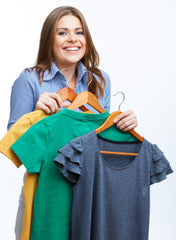What Tintex Dyes
Often people will ask questions and we are happy to help you know the best fabrics to use. Tintex is for most washable fabric and cord made up of natural or synthetic fibres. Know what fabric you are working with before you dye. Fabric content, weight, desired dye colour intensity and dyeing method are always the starting point of every project.
You can dye many common organic items around your home too. Get creative and add colour to update clothes, renew home accents or make colourful crafts for your friends & family.
Fabric content can vary from natural, synthetic or a blend of both (ex: 'satin' could be made of: silk, a silk-blend or even polyester). If you are dyeing fabric (ex: clothing, napkins, placemats, towels or bed linens etc.) look on the care label to find out what the fabric content is. It is often located behind the designer tag on the back or on a separate tag on the side seam.

Dye These Natural & Synthetic Fabrics:
- Cotton, linen, wool, silk (you may test other natural fibres)
- Rayon, nylon, spandex, viscose
- Fabric blends are dyeable (Tintex is not suitable for 100% polyester or 100% acrylic items)
Dye-Stain These Materials:
- Unfinished wood furniture and frames
- Wicker, straw or bamboo baskets, decorative pinecones
- Card making paper and paper lanterns
- Cork, feathers, seashells, eggshells, and dried (light coloured) macaroni or beans
For the best dyeing results, follow the product instructions. Keep water temperatures at 140°F to get the best dyeing results. Ensure that your fabric is clean & damp before dyeing. Some dyeing techniques (ex: using a spray bottle, drizzling or stamping or painting) can be done dry if needed depending on desired results and material used. Always test new methods to get familiar with the process because results may vary.
Tintex is not food grade and is designed for fabric or crafts (ex: not for colouring hair). Always supervise small children while dyeing.



